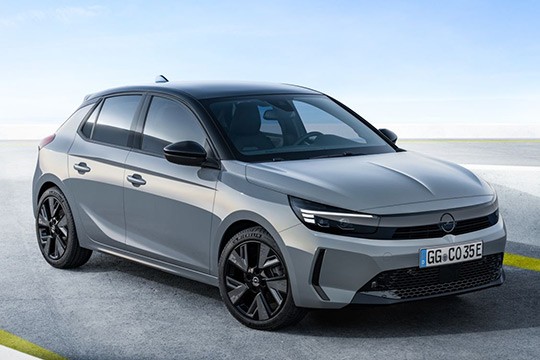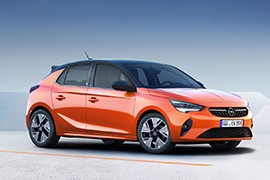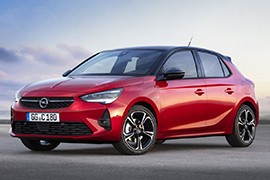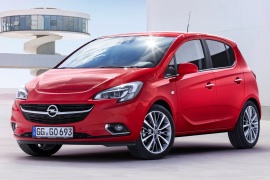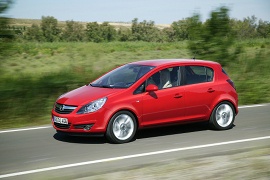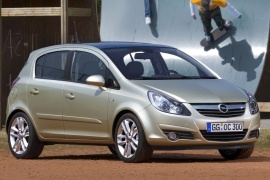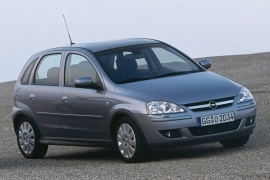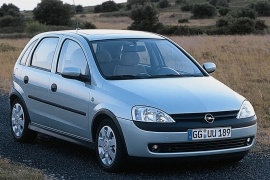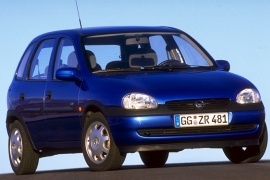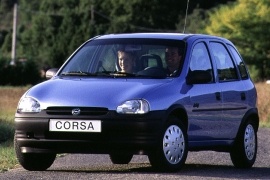OPEL Corsa 5 Doors Models/Series Timeline, Specifications & Photos
First production year: 1993
Engines: Electric, Hybrid gasoline, Gasoline, Diesel, Natural gas
Body style: Hatchback
For the past forty years, the Opel Corsa has been a familiar sight on streets worldwide, being under various brand names like Vauxhall, Chevrolet, and Holden, and enhancing people's everyday lives.
With the introduction of its seventh generation, the Corsa elevates the comfort and joy it brings customers through a technologically advanced experience and intuitive controls.
In line with its ambitious goal of exclusively selling electric vehicles by 2028, Opel has embraced hybrid and fully electric versions of the new Corsa. The electric variant offers an impressive range of up to 250 miles (400 km) and boasts a rapid charging time of just 30 minutes, taking the battery from 20 to 80 percent. With a maximum output of 156 horsepower, the electric versions provide ample power for the car's everyday driving needs.
The new Opel Corsa showcases impeccable proportions and meticulous attention to detail, and all encompassed within a confident and streamlined exterior design. The designers have propelled this beloved small car into the realms of modernity and style.
An outstanding feature is the unmistakable Opel Vizor, the iconic face that graces all of Opel's latest models. This black visor seamlessly integrates the Corsa's front, merging the vehicle grille, LED headlights, and central Opel Blitz into a harmonious element.
The brand logo, available in attention-grabbing black or matte satin silver, commands attention on both the front and rear, depending on the trim level. Notably, the enlarged and prominent optical air inlets in the lower front bumper area further enhance the vehicle's presence on the road.
As an available feature, the new Corsa presents a fully digital cockpit powered by Snapdragon Cockpit Platforms from Qualcomm Technologies. This advanced setup includes intuitive infotainment and a vibrant, up to 10-inch color touchscreen, elevating the overall driving experience.
Building upon the innovation introduced by the Corsa in 2019, the glare-free Intelli-Lux LED matrix light has been further improved, now equipped with 14 LED elements instead of 8, for extra precision and performance. The headlights have also been upgraded software-wise, being capable of cutting out incoming traffic better than before, ensuring a pleasant driving experience for all the traffic participants.
By introducing a new, high-resolution panoramic rear-view camera, Opel Corsa is tailored to be the city car you didn't know you needed. The high-resolution camera captures detailed images, even in challenging lighting conditions, ensuring that no obstacle or potential hazard goes unnoticed.
With its panoramic view, drivers can effortlessly maneuver in tight spaces, park precisely, and comprehensively understand the rear environment.
All the vehicle's features combined with its modern and robust appearance make the Corsa a real contender for the best-selling compact car, a title it had earned in the past in its country of origin, Germany.
The German carmaker Opel, now allied with the French group PSA (Peugeot-Citroen), has managed to launch its first electric model: the Corsa-e. The model uses the same technical platform as its sibling, the Peugeot 208-e, with both models having been launched in 2019. The Corsa name has been on the market since 1982 and more than 13.6 million units have been sold since.
The power comes from a 100 kW electric motor with 260 Nm (191.8 lb-ft) of torque. Thanks to a 50 kWh battery pack installed in the floor, the total claimed range under WLTP norms is 330 km (205 miles). But Opel insisted that the car shouldn't offer a boring drive so it made it fast enough to bring a smile on electric-cars lovers. The sprint from 0 to 50 kph (31 mph) is obtained in less than three seconds while the 0-100 kph (62 mph) acceleration takes 8.2 seconds.
On the outside, the Opel Corsa-e brings full-MatrixLED headlights, an industry first for the small-vehicle category. This means that 8 LEDs on each headlight are changing their light pattern according to information received from a frontal camera.
Inside, Opel offers as standard a 7” touchscreen display unit for the multimedia system. As an option, there is a 10” unit available, which includes the Opel Connect telematics system that can be accessed via an app on the smartphone.
This is the sixth generation of the Corsa and the model's roots go way back to 1982. Now, the German brother of the PSA group has launched a new generation of its small car, but some might say that it is very close technically to the new Peugeot 208.
The styling, of course, is genuine Opel and, for the first time, it is available with LED headlights on the whole range, regardless the engine type.
For the bodywork, the manufacturer decided to put the car on a drastic diet, reducing its base model weight bellow 1000 kg (2204 lbs), which is impressive if we take into account that the vehicle is equipped with all the mandatory modern safety features.
For the engine department, Opel offers a small range of variants, gasoline and electric. The base model has a 1.2-liter three-cylinder gasoline engine with 75 HP, while the top version is a pumped-up turbocharged version of its base model, but offers 130 HP. They worked hard to keep the fuel consumption low. According to the newest WLTP form, the new Corsa can use between 3.6 and 6.1 liter/100 km (65.3 mpg – 38.5 mpg) depending on the engine.
For those who are willing to pack a full list of options on a city car, the Corsa can be equipped with an 8-speed AT transmission. The base models has a 5-speed manual transmission, though.
The fifth generation of the Opel Corsa marked its debut at the 2014 Paris Motor Show. It was the last Corsa generation completely developed by the German car-maker before it was taken over by PSA (Peugeot-Citroen).
After almost 12 million units sold in 32 years, the Corsa was a big success from the German car-maker. The fifth-generation grew in size to 4.02 meters (158.3”) from the initial 3.62 m (142.6”) length of the first generation in 1982. It also grew in features and comfort.
The front fascia was characterized by the “wing” shaped headlights, which incorporated the Opel's signature and LED daytime running lights. The sporty trapezoidal grille featured the chromed Opel badge. A lip-spoiler was installed on the lower part of the apron, and two side air-intakes hosted the fog-lights (if mounted). Due to its subtle side sculptures on the front and rear doors and rear fenders, the car looked longer than it was.
Inside, the car featured five seats, with easy access due to its four doors. On the base models, the dashboard was simple and plain, with a center stack where the radio and climate controls were installed. The instrument cluster was simple and easy to read. On higher trim levels, a new infotainment unit was installed with a 7” touch-screen. It featured connectivity with Apple CarPlay and Android Auto.
The car offered a wide choice of diesel and gasoline engines. Depending on the power version, it was available with a 5- or 6-speed manual fitted as standard. A 6-speed automatic or 5-speed automated gearbox was on the options list.
OPEL Corsa 5 Doors 1.0L ECOTEC 6MT (115 HP)
OPEL Corsa 5 Doors 1.0L ECOTEC 6MT (90 HP)
OPEL Corsa 5 Doors 1.2L 5MT (70 HP)
OPEL Corsa 5 Doors 1.4L 5MT (90 HP)
OPEL Corsa 5 Doors 1.4L ecoFLEX 5AT (90 HP)
OPEL Corsa 5 Doors 1.4L ecoFLEX 5MT (90 HP)
OPEL Corsa 5 Doors 1.4L ecoFLEX 6AT (90 HP)
The Opel Corsa was a strong player in the small car segment starting with 1982.
The successful 6th generation Opel Corsa was updated in 2010. Besides more available features and a redesigned face, Opel introduced a new range of engines compliant to the Euro 5 emission standards.
With the redesigned front grille, the reshaped headlamps and the refreshed radiator grille, the new Corsa feature a more expressive and sportier look.
To further personalise the small car, Opel introduced new exterior colors and interior looks.
Inside, Opel installed a new infotainment system called “Touch & Connect” that came with a 5-inch color touchscreen, a navigation system, Bluetooth connectivity, as well as iPod and USB connections.
While from the outside, the Corsa seemed rather small, the interior space was surprising, for both the front and the rear occupants.
Not many competitors in the segment offered the features available with the Corsa, such as a heated steering wheel, halogen Adaptive Forward Lighting, Hill Start Assist, a panorama sunroof or an integrated bicycle carrier.
The entire range of engines was reworked to offer more power, lower fuel consumption and reduced CO2 emissions. The diesel powerplants’ power ranged between 75 hp and 130 hp, while the most powerful 1.6-liter turbo that offered 192 hp was to be found on the sportier Opel Corsa OPC.
Comfort was also enhanced in 2010 as the chassis received significant improvements. Opel revised the dampers, the springs, the anti-roll bars, the steering gear and the ESP, thus the new Corsa was more refined and offered improved stability.
The fourth generation of the Corsa was introduced in 2006. It had the world premiere in London and the sales started immediately, with big success on the market.
The Corsa was a joint development between General Motors and Fiat. While the Italians produced the Fiat Punto and the Alfa Romeo MiTo, Opel got the Corsa. It even had some engines from Italy, but not the design. The exterior was Opel's project.
Compared to its predecessor, the new generation was bigger and its headlights swept-back on the fenders left the impression of a compact-sized car. The side view resembled its bigger sibling Astra. The rear doors had that specific cut at the C-pillar that brought that idea. In the back, the elliptic taillights were mounted above the rear bumper to be protected from parking, low-speed crashes.
Inside, the Corsa offered good space for four adults. The rear doors made access to the bench easier. In the front, the two seats were placed higher so the driver could have a better view on the road. But the rather dull dashboard, with a center stack that looked like a sad robot with the round vents in the middle, was not as pleasant as the rest of the car.
With a McPherson suspension in the front and a semi-independent one for the rear, the Corsa was a typical city vehicle. It was offered with a choice of gasoline and diesel engines from both car-makers. It was available with a 5- or 6-speed manual, depending on the engine. There was also an option for a 4-speed automatic or a 6-speed automated, with an electronically controlled clutch.
Opel introduced a mid-life cycle refresh for the Corsa in 2003, after four years since the launch of its third generation.
The little Corsa gained its respect on the market, and Opel felt like the car needed more attention for it. Its customers asked for a fancier appearance, and the carmaker improved it in all areas.
On the outside, the small-segment Corsa received body-colored handles and door mirrors for the upper trim levels instead of black as on its non-facelifted version. Also, the black rubber stripes from the bumpers and on the sides were replaced following the car's color. Moreover, the little vehicle received a sportier bumper with two side-scoops that flanked the center grille on the lower apron, where Opel installed fog lights as an option.
Inside, the carmaker kept the same look but with better materials. The carmaker installed white dials inside the instrument cluster for the upper trim levels depending on the options. Its base models retained the black ones. There were several options for the climate controls, either manual or automatic systems.
Under the hood, Opel installed new or improved engines. The base, inline-three, one-liter unit gained two more ponies. For the diesel version, the German carmaker introduced a new, 1.3-liter unit carried over from Fiat, while the older 1.7-liter four-pot made by Isuzu was increased to 100 hp.
The third generation of the Corsa was unveiled in 1999 as a 2000 model and it was the smallest car offered by the German car-maker on the European market. It was available in three or five-door configurations.
The small-segment hatchback market in Europe was highly contested in the 2000s by most of the car-makers, from Italy, Japan, France, and Germany. It was a highly competitive segment and important due to its high volume. The Corsa itself was sold in more than 500.000 units a year and that made it an important player in the segment.
The new “edge” design trend affected the little 5-door Corsa and the designers installed bigger headlights with an angle toward the grille. The small doors provided access for both front and rear seats. Right behind the rear doors, a small, and narrow, a vertical side window was included in the C-pillar. That was a Corsa-specific feature in the small-segment. To protect the taillights from scratches and parking bumps, they were installed on the C-pillars.
Inside, the car featured good amenities for its segment, even though the base model didn't feature power-windows or air-conditioning. Moving up to the trim level and options list, the Corsa was fitted with a good sound system with CD-player, on-board computer, and four power-windows.
The Corsa was available with a wide choice of engines ranged between 1.0-liter and 1.7 liters, both gasoline, and two turbodiesels. The standard transmission for the entire range was with a 5-speed manual. There was an option for a 4-speed automatic or a 5-speed automated (Easytronic). The top of the range engine, 1.8-liter gasoline, was available only for the 3-door version.
Opel refreshed the second generation of the Corsa in 1997 for both versions with three and five doors, improving its look and enhancing the engine lineup.
Four years after the introduction of the second generation, Opel considered that a facelift was required and did some work on the technical side, while the design remained mostly the same as on its non-facelifted version. It was sold in the U.K as Holden Corsa and in Australia, later on, as Holden Barina.
The first generation of the Corsa was wedged-shaped and featured straight lines and barely curved surfaces, while its successor came in the middle of the bio-design era, where the curved shapes dominated the car design industry. Its egg-shaped headlights and narrow black grille formed a small front fascia. Its wrapped-around bumper sported a black rubber area on the top and, depending on the version, a pair of fog lights on the lower side. Opel insisted on installing three windows to make a slimmer rear pillar and enhance the driver's visibility to the rear three-quarter.
Inside, there were small changes to the interior, but Opel installed a standard airbag for the driver, leading to a new steering wheel. Also, it included a new design for the gear stick to match the new wheel. The carmaker included new materials and colors for the upholstery and door panels, but the dashboard was available only as black. In the back, the seat was fit for three children or just two adults.
Under the hood, the carmaker enhanced the engine lineup and removed the 1.6-liter version from the offer. It replaced it with a punchier 1.8-liter unit. For the diesel versions, Opel offered three versions ranged between 50 hp and 67 hp.
Opel introduced the second generation of the Corsa in 1993, and General Motors developed the project as a world car.
The first generation of the Corsa was a hit for the European carmaker Opel, who sold it as Vauxhall Nova in the U.K. For the second generation, the carmaker dropped the Nova nameplate for the British market and used the Corsa. GM thought that this might be a suitable vehicle in more countries and exported the project to Australia, China, South America, and India. It became a global success.
Hideo Kodama designed the car in Russelsheim, Germany, became one of the best examples of bio-design cars in its segment. At the front, there was a mild blend of straight lines and curved corners. Its wrapped-around plastic bumper was black for the lower trim levels and body-colored for the upper ones. The rounded headlights with corner-mounted turn signals were narrower on their inner side. A narrow grille with a horizontal slat sported the Opel badge in the middle. From its sides, the five-door Corsa featured black and flush door handles and door mirrors while a black rubber strip crossed the doors. Despite its small size, the Corsa sported a third window area behind the rear bench.
Inside, the carmaker made room for two adults at the front and three in the back. Although, only for very short distances since there was very limited knee room. On the dashboard, depending on the engine and trim level, the carmaker installed an instrument cluster with four dials for the upper trim levels or just three for the lower ones. Since it was built to fight for the top position in the European sales charts, the Corsa received an air-conditioning unit as an option.
Under the hood, Opel installed a choice of eight engines, both gasoline, and diesel.
